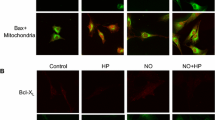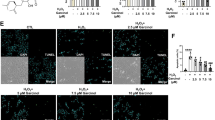Abstract
Tumor necrosis factor-alpha (TNFα) plays a crucial role in inflammatory diseases such as rheumatoid arthritis and postmenopausal osteoporosis. Recently, it has been demonstrated that hydrogen gas, known as a novel antioxidant, can exert therapeutic anti-inflammatory effect in many diseases. In this study, we investigated the effect of treatment with hydrogen molecule (H2) on TNFα-induced cell injury in osteoblast. The osteoblasts isolated from neonatal rat calvariae were cultured. It was found that TNFα suppressed cell viability, induced cell apoptosis, suppressed Runx2 mRNA expression, and inhibited alkaline phosphatase activity, which was reversed by co-incubation with H2. Incubation with TNFα-enhanced intracellular reactive oxygen species (ROS) formation and malondialdehyde production increased NADPH oxidase activity, impaired mitochondrial function marked by increased mitochondrial ROS formation and decreased mitochondrial membrane potential and ATP synthesis, and suppressed activities of antioxidant enzymes including SOD and catalase, which were restored by co-incubation with H2. Treatment with H2 inhibited TNFα-induced activation of NFκB pathway. In addition, treatment with H2 inhibited TNFα-induced nitric oxide (NO) formation through inhibiting iNOS activity. Treatment with H2 inhibited TNFα-induced IL-6 and ICAM-1 mRNA expression. In conclusion, treatment with H2 alleviates TNFα-induced cell injury in osteoblast through abating oxidative stress, preserving mitochondrial function, suppressing inflammation, and enhancing NO bioavailability.





Similar content being viewed by others
References
Feldmann M, Brennan FM, Maini RN (1996) Role of cytokines in rheumatoid arthritis. Annu Rev Immunol 14:397–440
Romas E, Martin TJ (1997) Cytokines in the pathogenesis of osteoporosis. Osteoporos Int 7:S47–S53
Zheng SX, Vrindts Y, Lopez M, De Groote D, Zangerle PF, Collette J, Franchimont N, Geenen V, Albert A, Reginster JY (1997) Increase in cytokine production (IL-1 beta, IL-6, TNF-alpha but not IFN-gamma, GM-CSF or LIF) by stimulated whole blood cells in postmenopausal osteoporosis. Maturitas 26:63–71
Kastelan D, Kastelan M, Massari LP, Korsic M (2006) Possible association of psoriasis and reduced bone mineral density due to increased TNF-alpha and IL-6 concentrations. Med Hypotheses 67:1403–1405
Scott DL, Kingsley GH (2006) Tumor necrosis factor inhibitors for rheumatoid arthritis. New Engl J Med 355:704–712
Feldmann M, Maini RN (2001) Anti-TNF alpha therapy of rheumatoid arthritis: what have we learned? Annu Rev Immunol 19:163–196
Kuno H, Kurian SM, Hendy GN, White J, deLuca HF, Evans CO, Nanes MS (1994) Inhibition of 1, 25-dihydroxyvitamin D3 stimulated osteocalcin gene transcription by tumor necrosis factor-alpha: structural determinants within the vitamin D response element. Endocrinology 134:2524–2531
Kitajima I, Soejima Y, Takasaki I, Beppu H, Tokioka T, Maruyama I (1996) Ceramide-induced nuclear translocation of NF-kappa B is a potential mediator of the apoptotic response to TNF-alpha in murine clonal osteoblasts. Bone 19:263–270
Gilbert L, He X, Farmer P, Boden S, Kozlowski M, Rubin J, Nanes MS (2000) Inhibition of osteoblast differentiation by tumor necrosis factor-alpha. Endocrinology 141:3956–3964
Xie KL, Yu YH, Pei YP, Hou L, Chen S, Xiong L, Wang G (2010) Protective effects of hydrogen gas on murine polymicrobial sepsis via reducing oxidative stress and HMGB1 release. Shock 34:90–97
Xie K, Yu Y, Huang Y, Zheng L, Li J, Chen H, Han H, Hou L, Gong G, Wang G (2012) Molecular hydrogen ameliorates lipopolysaccharide-induced acute lung injury in mice through reducing inflammation and apoptosis. Shock 37:548–555
Xu Z, Zhou J, Cai J, Zhu Z, Sun X, Jiang C (2012) Anti-inflammation effects of hydrogen saline in LPS activated macrophages and carrageenan induced paw oedema. J Inflamm 9:2–8
Ji X, Tian Y, Xie K, Liu W, Qu Y, Fei Z (2012) Protective effects of hydrogen-rich saline in a rat model of traumatic brain injury Via reducing oxidative stress. J Surg Res. 2012 Mar 22. [Epub ahead of print]
Yu YS, Zheng H (2012) Chronic hydrogen-rich saline treatment reduces oxidative stress and attenuates left ventricular hypertrophy in spontaneous hypertensive rats. Mol Cell Biochem 365:233–242
Zheng H, Yu YS (2012) Chronic hydrogen-rich saline treatment attenuates vascular dysfunction in spontaneous hypertensive rats. Biochem Pharmacol 83:1269–1277
Chang WJ, Toledo-Pereyra LH (2012) The potential benefits of hydrogen-rich saline in ischemia and reperfusion injury. J Surg Res. 2012 Mar 10. [Epub ahead of print]
Moursi A, Damsky C, Lull J, Zimmerman D, Doty S, Aota S, Globus R (1996) Fibronectin regulates calvarial osteoblast differentiation. J Cell Sci 109:1369–1380
Ohsawa I, Ishikawa M, Takahashi K, Watanabe M, Nishimaki K, Yamagata K, Katsura K, Katayama Y, Asoh S, Ohta S (2007) Hydrogen acts as a therapeutic antioxidant by selectively reducing cytotoxic oxygen radicals. Nat Med 13:688–694
Kojima H, Urano Y, Kikuchi K, Higuchi T, Hirata Y, Nagano T (1999) Fluorescent indicators for imaging nitric oxide production. Angew Chem Int Ed 38:3209–3212
Rao PV, Maddala R, John F, Zigler JS Jr (2004) Expression of nonphagocytic NADPH oxidase system in the ocular lens. Mol Vis 10:112–121
Lu CY, Lee HC, Fahn HJ, Wei YH (1999) Oxidative damage elicited by imbalance of free radical scavenging enzymes is associated with large-scale mtDNA deletions in aging human skin. Mutat Res 423:11–21
Spitz DR, Oberley LW (1989) An assay for superoxide dismutase activity in mammalian tissue homogenates. Anal Biochem 179:8–18
Elks CM, Mariappan N, Haque M, Guggilam A, Majid DS, Francis J (2009) Chronic NF-kB blockade reduces cytosolic and mitochondrial oxidative stress and attenuates renal injury and hypertension in SHR. Am J Physiol Renal Physiol 296:F298–F305
Sun Y, Shuang F, Chen DM, Zhou RB (2012). Treatment of hydrogen molecule abates oxidative stress and alleviates bone loss induced by modeled microgravity in rats. Osteoporos Int (in press)
Mandal CC, Ganapathy S, Gorin Y, Mahadev K, Block K, Abboud HE, Harris SE, Ghosh-Choudhury G, Ghosh-Choudhury N (2010) Reactive oxygen species derived from Nox4 mediate BMP2 gene transcription and osteoblast differentiation. Biochem J 433:393–402
Wittrant Y, Gorin Y, Mohan S, Wagner B, Abboud-Werner SL (2009) Colony-stimulating factor-1 (CSF-1) directly inhibits receptor activator of nuclear factor-{kappa}B ligand (RANKL) expression by osteoblasts. Endocrinology 150:4977–4988
Muller FL, Song W, Liu Y, Chaudhuri A, Pieke-Dahl S, Strong R, Huang TT, Epstein CJ, Roberts LJ 2nd, Csete M, Faulkner JA, Van Remmen H (2006) Absence of CuZn superoxide dismutase leads to elevated oxidative stress and acceleration of age-dependent skeletal muscle atrophy. Free Radic Biol Med 40:1993–2004
Noor R, Mittal S, Iqbal J (2002) Superoxide dismutase-applications and relevance to human diseases. Med Sci Monit 8:210–215
Smietana MJ, Arruda EM, Faulkner JA, Brooks SV, Larkin LM (2010) Reactive oxygen species on bone mineral density and mechanics in Cu, Zn superoxide dismutase (Sod1) knockout mice. Biochem Biophys Res Commun 403:149–153
Lean JM, Jagger CJ, Kirstein B, Fuller K, Chambers TJ (2005) Hydrogen peroxide is essential for estrogen-deficiency bone loss and osteoclast formation. Endocrinology 146:728–735
Chang J, Wang Z, Tang E, Fan Z, McCauley L, Franceschi R, Guan K, Krebsbach PH, Wang CY (2009) Inhibition of osteoblastic bone formation by nuclear factor-kappaB. Nat Med 15:682–689
Li Y, Li A, Strait K, Zhang H, Nanes MS, Weitzmann MN (2007) Endogenous TNFalpha lowers maximum peak bone mass and inhibits osteoblastic smad activation, through NF-kappaB. J Bone Miner Res 22:646–655
Kurokouchi K, Kambe F, Yasukawa K, Izumi R, Ishiguro N, Iwata H, Seo H (1998) TNF-alpha increases expression of IL-6 and ICAM-1 genes through activation of NF-kappaB in osteoblast-like ROS17/2.8 cells. J Bone Miner Res 13:1290–1299
Armour KE, Van’T Hof RJ, Grabowski PS, Reid DM, Ralston SH (1999) Evidence for a pathogenic role of nitric oxide in inflammation-induced osteoporosis. J Bone Miner Res 14:2137–2142
Chen RM, Chen TL, Chiu WT, Chang CC (2005) Molecular mechanism of nitric oxide-induced osteoblast apoptosis. J Orthop Res 23:462–468
MacPherson H, Noble BS, Ralston SH (1999) Expression and functional role of nitric oxide synthase isoforms in human osteoblast-like cells. Bone 24:179–185
Yan L, Yinghui T, Bo Y, Gang Z, Xian X, Lu Z (2011) Effect of calcitonin gene-related peptide on nitric oxide production in osteoblasts: an experimental study. Cell Biol Int 35:757–765
Yin H, Shi ZG, Yu YS, Hu J, Wang R, Luan ZP, Guo DH (2012) Protection against osteoporosis by statins is linked to a reduction of oxidative stress and restoration of nitric oxide formation in aged and ovariectomized rats. Eur J Pharmacol 674:200–206
Author information
Authors and Affiliations
Corresponding author
Rights and permissions
About this article
Cite this article
Cai, WW., Zhang, MH., Yu, YS. et al. Treatment with hydrogen molecule alleviates TNFα-induced cell injury in osteoblast. Mol Cell Biochem 373, 1–9 (2013). https://doi.org/10.1007/s11010-012-1450-4
Received:
Accepted:
Published:
Issue Date:
DOI: https://doi.org/10.1007/s11010-012-1450-4




